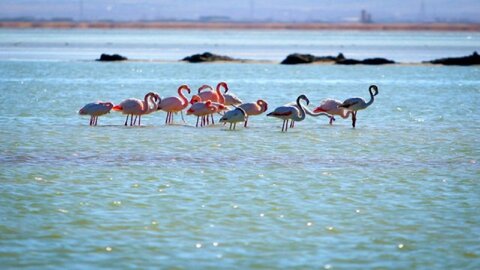Iran (IMNA) - The bird's flocks, which include identical males and females, typically build nests on the ground, fly in a V-shaped formation, and spend a lot of time in water regions, plains, and fields surrounding lakes.
Now, a number of common cranes have been recognized on Lake Urmia's southern side. They have chosen the location as a stopping spot due to the availability of appropriate amount of water, food supplies, and habitat safety.
Flamingos observed in the Suldoz wetland
Every summer, migratory flamingos travel from the northern areas of Lake Urmia to the wetlands like Suldoz and Dargahe Sangi in the southwestern section of Lake Urmia.
The number of migratory flamingos in the marsh is rising; the birds come in big flocks of 200 to 250 individuals. Qaemi added that they relax and graze in the swamp for a while before continuing on their journey to the southern areas.

Iran is an important stopover for migrating birds
According to a Department of Environment official, Iran is the most significant country in West Asia for sheltering migrating birds in winter, with around two million birds flying to the country's wetlands each year.
Every year, millions of migrating birds visit Iran, which is home to various marshes, and reservoirs.
The country has also emerged as the most significant stopover for migratory birds on their passage from Siberia to the Nile, with sixteen percent choosing to spend the winter there. A varied range of migratory birds travel to Iran, with over 160 species of aquatic and waterside birds documented, which is a large amount
Despite restricted water supplies in the country's domestic habitats, research on migratory bird fluctuations suggests that the quantity and diversity of birds entering the country have not reduced. However, the majority have traveled to the Caspian and Persian Gulf coasts.

Iran hosts more than 5% of the world's migrating birds in 450 locations throughout the winter
Every year some 30 to 40 million birds are counted all over the world and the related statistics are recorded in the International Waterfowl Census (IWC) database. The collected data and accompanying analysis had substantial scientific significance in terms of wetlands, beaches, and biodiversity conservation.
In 1976, Iran became the first West Asian country to participate in the worldwide wintering waterbird census with European countries. In the early years, water bird counts were confined to huntable species such as swans, geese, ducks, and common tern. Since 1987, other water birds have been added to the list.
Thanks to favorable geographical conditions, climatic diversity, wetlands, and aquatic habitats, including the Caspian Sea in the north, the Persian Gulf, and the Oman Sea in the south, Iran hosts millions of migratory and wintering waterbirds yearly. Therefore, Iranian Department of Environment has prioritized the counting of wintering water birds for the past six decades.
Over the previous three decades, an average of 8.1 million birds have been counted, accounting for approximately 5% of the world's migratory bird population and more than 16% of the population of migrant birds taking the route from Siberia to the Nile.



Your Comment